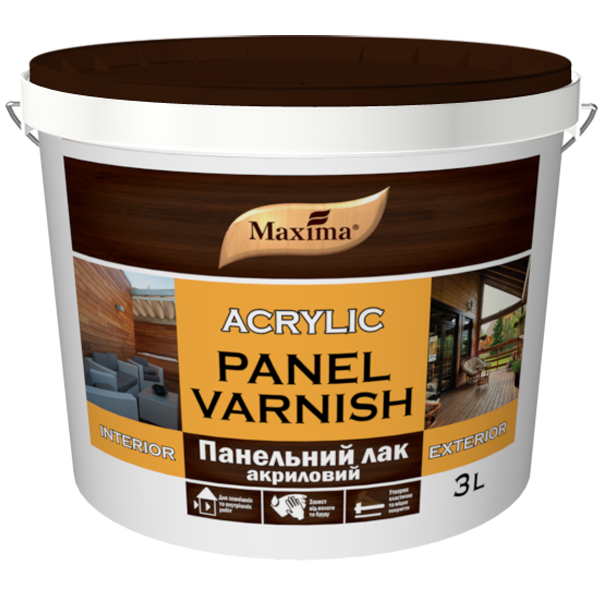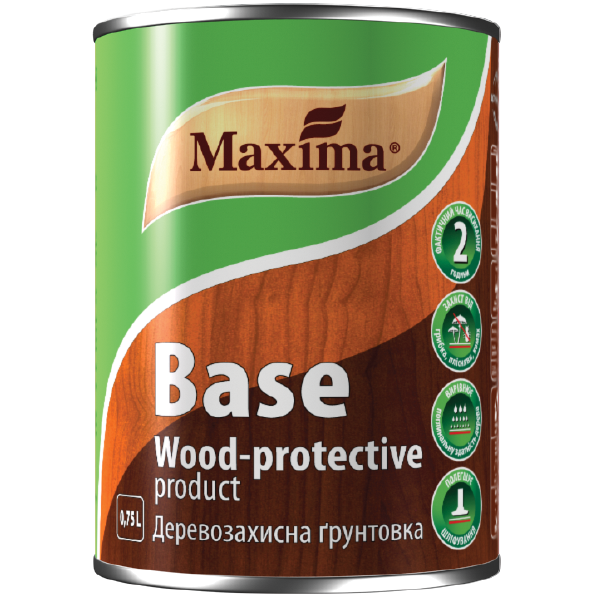
Specification
It is resistant to advanced humidity, temperature fluhtuation and other weather effects. It reliably protects wood against pest, mould and fungi. It had advanced resistance to abrasion, scratches, strikes and other mechanical load. It has perfect flexibility (it doesn't crack thorugh the time). It gives wood perfect decorative properties. It has optimized drying period.
Sphere of application
It is intended for decorative protection of wooden above water and interior parts of sea and river ships as well as for window frames, doors and other wooden surfaces.
Content
Technical data
| Consumption standard of 1 layer | 60-80 ml/m2., depending on the way of application and type of surface. |
| Solvent | Оdorless solvent ТМ Maxima, maximum of 10% from the varnish weight. |
| Application | Apply with a brush, a roller or a spraying gun. |
| Drying period (23 °С, 50% RH) | 4 hours. Drying period increases if the temperature is getting down and relative air humidity is getting higher. |
| Gloss (DSTU ISO 2813) | matt – max. 30 GU semi-matt – 30-60 GU glossy – min. 100 GU (at 60º) |
| Hardness (DSTU ISO 1522) | ≈ 75 sec., Konig pendulum. |
| Solids content (DSTU ISO 3251) | 49±2 %, depending on the gloss degree. |
| Density (DSTU ISO 2811-1) | 0,92-0,94 g/cm3, depending on the gloss degree. |
| VOC content (ISO 11890) | 475±10 g/l, depending on the gloss degree. |
| Non-volatile matter by volume (DSTU ISO 3233) |
40±2 % |
| Warranty period | 24 months from the date of manufacturing. |
| Packaging | 0,75 l, 2,5 l, 20 l |
Gloss
Color
Application instruction
-
1. Preliminary preparation
The surface shall be dry (maximum humidity is 20%). Clean thoroughly from dirt, grease, dust, wax and polishing products.
Surfaces, previously coated with the mixture of varnish with solvent, shall be cleaned from old loose and weak coats. After that sandpaper it till matt condition.
Previously coated surface by acrylic varnish shall be cleaned completely from the varnish.
Polishing is performed in two steps. The surface is polished up with coarse-grained abrasive paper, then finished with fine-grained abrasive paper.
Defected surfaces (holes, rends, cracks) shall be filled with Putty for wood ТМ Farbex in a proper tinter. After that, the surface shall be polished up.
It is recommended to avoid cleaning methods which can damage wood fibers (for example sandblast apparatus).
2. Priming
Previously varnished wooden surfaces do not require undercoating.
Previously untreated wooden surfaces shall be coated with Wood-protective product "Base" TM Maxima.
Edges of wooden products shall be treated more carefully and completely impregnated.
3. Application
Make sure that the primed cover is dry enough before applying the finish coating.
Stir the varnish thoroughly before use.
Apply the undiluted varnish in 1-3 coats with a brush or a roller on undercoating surfaces. In the case of applying with a spraying gun, the varnish shall be diluted with solvent.
The application of the next coat shall be provided in 24 hours.
It is recommended to polish intermediate coats with small-grained sandpaper.
Do not apply a thick coat of varnish!
Application is performed at the temperature from + 10 °С till + 35 °С and relative air humidity no more than 80%. Do not apply the varnish under direct sunlight, strong wind, frost and atmospheric precipitation. After the coating is applied it shall not be affected by atmospheric precipitation for 24 hours.
The surface is ready to use in 48 hours. Complete hardening and achieving of its properties shall be in 14 hours.
4. Tool cleaning
Clean tools with solvent after application. The dry product shall be removed from the tools in mechanical way.
You may also be interested in
Use with this product
Tips

Як вибрати лак для дерева для внутрішніх і зовнішніх робіт: види лаків
Лак для дерева – це одночасно захист деревини і збереження її природної краси. Дерево вразливий матеріал. Шкідники, дія вологи, перепади температур – все це несе негативний вплив і без захисного покриття деревина швидко втрачає естетичну привабливість і цілісність основи. Хоча …

Які бувають лаки для дерева
Дерево – це той будівельний матеріал, застосування якого можна побачити практично на кожному кроці. Із дерева будують домівки, паркани, роблять меблі та використовують для оздоблення та декору інтер’єра. Завдяки своїй природній красі, унікальній структурі дерево дуже красивий та екологічний матеріал. …
Flow calculator
Consumption standard of 1 layer
When calculating the area to be painted, you need to subtract the area that will not be painted. (windows, doors, etc.)
Paint consumption may vary depending on dilution and uniformity of application of the paint.









